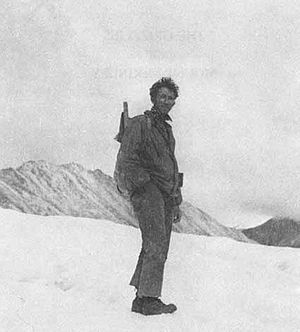Adolph Murie facts for kids
Quick facts for kids
Adolph Murie
|
|
|---|---|

Adolph Murie on Muldrow Glacier, 1939, Mount McKinley National Park
|
|
| Born | September 6, 1899 Moorhead, Minnesota |
| Died | August 16, 1974 (aged 74) Moose, Wyoming |
| Occupation | Author, ecologist, forester, wildlife biologist, and environmentalist |
| Nationality | American |
| Alma mater | University of Michigan |
| Subject | Conservation, Wilderness Preservation, Animal Behaviors |
| Notable works | Wolves of Mount McKinley A Naturalist in Alaska |
| Spouse | Louise Murie |
Adolph Murie (born September 6, 1899 – died August 16, 1974) was a very important scientist. He was the first person to study wolves in their natural homes. He was a wildlife biologist and writer.
Adolph Murie was a pioneer in studying animals like wolves, bears, and other mammals and birds. He did this research in the wild, cold lands of Alaska. He also helped protect wolves from being hunted too much. He worked to keep places like Denali National Park and the Arctic National Wildlife Refuge safe and natural.
Contents
Early Life and Learning
Adolph Winstrom was born on September 6, 1899. His hometown was Moorhead, Minnesota. In 1922, before finishing college, Adolph went on an adventure. He joined his brother, Olaus Murie, on a trip to Mount McKinley National Park. This was the first of many trips he would make to Alaska.
He studied at Concordia College. Later, he went to the University of Michigan. There, he earned his Ph.D. in 1929. After that, he researched mammals in places like Guatemala and British Honduras.
Studying Animals in the Wild
In 1934, Adolph Murie started working for the National Park Service. He worked there for over 30 years! He even won a special award for his great service.
In 1937, Murie studied coyotes in Yellowstone National Park. He wrote a book called Ecology of the Coyote in Yellowstone. This book was very important. It argued against the idea of hunting predators like coyotes. Before this, the Park Service often tried to get rid of predators.
In 1939, the National Park Service asked Murie to study wolves. He looked at how wolves and Dall sheep lived together in the Mount McKinley area. He spent many hours watching them from 1939 to 1941. He even discovered that wolves ate mice!
His book, The Wolves of Mt. McKinley, is a famous book about nature. Because of his work, the Park Service stopped hunting predators in Yellowstone and Mount McKinley parks. He lived in a cabin called Sanctuary River Cabin No. 31 while doing his research. This cabin is now a historic place.
Protecting Wild Places
Adolph Murie and his brother, Olaus, worked hard to protect nature. They helped make national parks bigger. They also helped create new protected areas. One example is the Jackson Hole National Monument in 1943. This area later became part of Grand Teton National Park.
Adolph Murie's book, A Naturalist in Alaska, won the John Burroughs Medal in 1963. He also wrote many articles. These articles spoke out against hunting predators. They also warned against too many people disturbing wild areas. He wrote letters to Congress to protect places like Isle Royale and Grand Teton. He even wrote against using pesticides in parks.
His Lasting Impact
Adolph Murie passed away on August 16, 1974. He died at the STS Ranch in Moose, Wyoming. This ranch is now part of the Murie Ranch Historic District. It was named a special historic place in 1998.
Today, the Murie Center is based at the ranch. It is a group that helps people understand and protect wildlife and wild places. This is exactly what the Murie brothers spent their lives doing.
In 1976, Stanford University Law School started an award. It's called the "Olaus and Adolph Murie Award." It's given to students who do the best work in environmental law.
The Murie Science and Learning Center is in Denali National Park. It was named after Adolph Murie on August 16, 2004. This center is open all year. It helps visitors learn about the park, especially in winter.
Works by Adolph Murie
- Birds of Mount McKinley National Park, Alaska
- The ecological relationship of two subspecies of Peromyscys in the Glacier park region (Ann Arbor, Michigan: The University of Michigan Press, 1933)
- Fauna of the national parks of the United States. Ecology of the coyote in the Yellowstone (Washington, U.S. Govt. print office, 1940)
- Following fox trails (Ann Arbor, Mich., University of Michigan press, 1936)
- The Wolves of Mount McKinley (Seattle: University of Washington Press, 1985) ISBN: 0-295-96203-8
- The Grizzlies of Mount McKinley (Seattle: University of Washington Press, 1985) ISBN: 0-295-96204-6
- Mammals from Guatemala and British Honduras (Ann Arbor, Mich., University of Michigan press, 1935)
- Mammals of Denali (Alaska Natural History Association, 1994) ISBN: 0-930931-12-2
- The moose of Isle Royale (Ann Arbor, Mich., University of Michigan press, 1934)
- A naturalist in Alaska (Tucson: University of Arizona Press, 1990) ISBN: 0-8165-1168-3

